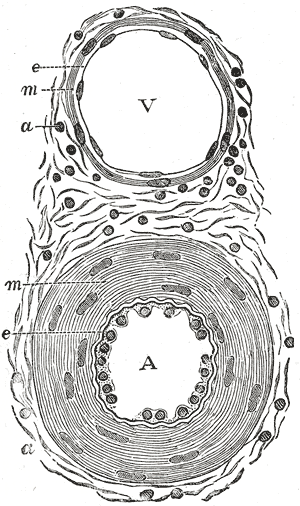Tunica externa
Tunica externa[edit]
The tunica externa (also known as the adventitia) is the outermost layer of a blood vessel, surrounding the tunica media. It is primarily composed of connective tissue and provides structural support and protection to the vessel. The tunica externa is an essential component of the vascular system, playing a crucial role in maintaining the integrity and function of blood vessels.
Structure[edit]
The tunica externa is composed mainly of collagen fibers, which provide strength and flexibility. In larger vessels, such as arteries and veins, the tunica externa also contains elastic fibers that allow the vessel to stretch and recoil. Additionally, the tunica externa houses small blood vessels known as the vasa vasorum, which supply blood to the walls of large vessels. Nerve fibers are also present, which help regulate the contraction and relaxation of the vessel walls.
Function[edit]
The primary function of the tunica externa is to protect the vessel from damage and to anchor it to surrounding tissues. It provides a supportive framework that helps maintain the shape and position of the vessel. The presence of the vasa vasorum ensures that the outer layers of large vessels receive adequate nutrients and oxygen, which is vital for their function and longevity.
Clinical significance[edit]
The tunica externa can be involved in various vascular diseases. For instance, in conditions such as atherosclerosis, the integrity of the vessel wall can be compromised, leading to the formation of plaques that can obstruct blood flow. The tunica externa may also be affected in aneurysms, where the vessel wall weakens and bulges outward, posing a risk of rupture.
Images[edit]




Related pages[edit]
References[edit]
<references group="" responsive="1"></references>
Tunica externa[edit]
-
Diagram of artery wall structure
-
Illustration of an artery
-
Gray's anatomy illustration of artery
-
Calcification in atherosclerotic artery
Ad. Transform your life with W8MD's Budget GLP-1 injections from $75


W8MD offers a medical weight loss program to lose weight in Philadelphia. Our physician-supervised medical weight loss provides:
- Weight loss injections in NYC (generic and brand names):
- Zepbound / Mounjaro, Wegovy / Ozempic, Saxenda
- Most insurances accepted or discounted self-pay rates. We will obtain insurance prior authorizations if needed.
- Generic GLP1 weight loss injections from $75 for the starting dose.
- Also offer prescription weight loss medications including Phentermine, Qsymia, Diethylpropion, Contrave etc.
NYC weight loss doctor appointmentsNYC weight loss doctor appointments
Start your NYC weight loss journey today at our NYC medical weight loss and Philadelphia medical weight loss clinics.
- Call 718-946-5500 to lose weight in NYC or for medical weight loss in Philadelphia 215-676-2334.
- Tags:NYC medical weight loss, Philadelphia lose weight Zepbound NYC, Budget GLP1 weight loss injections, Wegovy Philadelphia, Wegovy NYC, Philadelphia medical weight loss, Brookly weight loss and Wegovy NYC
|
WikiMD's Wellness Encyclopedia |
| Let Food Be Thy Medicine Medicine Thy Food - Hippocrates |
Medical Disclaimer: WikiMD is not a substitute for professional medical advice. The information on WikiMD is provided as an information resource only, may be incorrect, outdated or misleading, and is not to be used or relied on for any diagnostic or treatment purposes. Please consult your health care provider before making any healthcare decisions or for guidance about a specific medical condition. WikiMD expressly disclaims responsibility, and shall have no liability, for any damages, loss, injury, or liability whatsoever suffered as a result of your reliance on the information contained in this site. By visiting this site you agree to the foregoing terms and conditions, which may from time to time be changed or supplemented by WikiMD. If you do not agree to the foregoing terms and conditions, you should not enter or use this site. See full disclaimer.
Credits:Most images are courtesy of Wikimedia commons, and templates, categories Wikipedia, licensed under CC BY SA or similar.
Translate this page: - East Asian
中文,
日本,
한국어,
South Asian
हिन्दी,
தமிழ்,
తెలుగు,
Urdu,
ಕನ್ನಡ,
Southeast Asian
Indonesian,
Vietnamese,
Thai,
မြန်မာဘာသာ,
বাংলা
European
español,
Deutsch,
français,
Greek,
português do Brasil,
polski,
română,
русский,
Nederlands,
norsk,
svenska,
suomi,
Italian
Middle Eastern & African
عربى,
Turkish,
Persian,
Hebrew,
Afrikaans,
isiZulu,
Kiswahili,
Other
Bulgarian,
Hungarian,
Czech,
Swedish,
മലയാളം,
मराठी,
ਪੰਜਾਬੀ,
ગુજરાતી,
Portuguese,
Ukrainian



